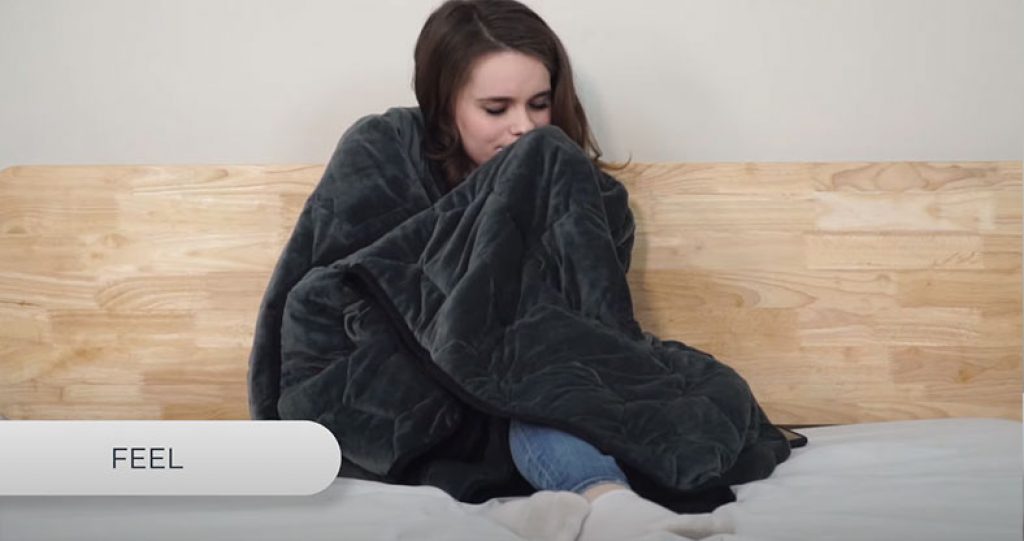Weighted blankets are heavier blankets often used as a therapeutic technique. These blankets can weigh between 5 and 30 pounds. Weighted blankets are heavier because they are filled with materials, such as micro glass beads or plastic pellets. The price of weighted blankets varies, depending on the brand. Some heavy blankets cost 25 dollars, while others are over 400 dollars. People can use heavy blankets at night and during the day.
Weighted blankets are typically used as a treatment for different mental health issues. These issues can include anxiety, obsessive-compulsive disorder (OCD), attention-deficit/hyperactivity disorder (ADHD), and panic episodes. People can use heavy blankets to manage certain sleep disorders, such as insomnia and restless legs syndrome (RLS). Heavy blankets are beneficial because they can improve your mood and help you sleep better.

Relieve Anxiety-induced Sleeplessness
Anxiety-induced sleeplessness means that someone can’t sleep because of anxiety. People need to relax in order to fall asleep, but anxious thoughts can prevent someone from feeling relaxed. Anxiety-based insomnia can cause sleep deprivation and poor sleep quality. Not getting adequate rest can impair your physical and cognitive capabilities while worsening your anxiety. Anxiety and sleep are closely linked because each one can exacerbate the other, creating a problematic cycle. A weighted blanket can provide comfort to relieve anxious thoughts at night.
Sleeping Better at Night
A weighted blanket can help you sleep better by working to treat certain sleep disorders and foster better rest. Weighted blankets can mitigate insomnia caused by anxiety or restless legs syndrome, two prominent sleep disorders. To achieve adequate rest, you need good sleep quality and enough hours of shuteye. Good sleep is important because it affects your physical, cognitive, and emotional well-being. You have more physical energy, improved cognitive function, and better moods when you rest well.
Melatonin Synthesis is aided with a Weighted Blanket
Melatonin synthesis is the process by which the body produces melatonin. Melatonin and sleep are closely connected. Melatonin is a hormone that promotes sleep as part of the body’s circadian rhythms. Circadian rhythms are physiological changes that occur within a 24-hour cycle, and they respond mostly to light and dark cues. When it’s dark out, melatonin amounts will increase. However, some people may need extra help with this. A weighted blanket can help by prompting the body to release serotonin. Serotonin is a precursor to melatonin in the synthesis process. Therefore, more serotonin can encourage more melatonin production, which could help you feel more tired.
A Hug is Imitated by a Weighted Blanket
A weighted blanket can provide a similar sensation to that of an embrace. Research has found that hugs reduce stress and anxiety, two culprits that can keep people up at night. Experts believe that hugs boost oxytocin levels. Oxytocin is a bonding hormone that helps people feel good. Increasing a positive hormone and reducing negative emotions should make it easier for someone to relax and fall asleep.
Obsessive-compulsive Disorder (OCD) is Relieved with a Weighted Blanket
Obsessive-compulsive disorder (OCD) is a mental health disorder in which someone has involuntary, recurring thoughts or behaviors. The thoughts are known as obsessions, and the behaviors are referred to as compulsions. People who have OCD report worse sleep quality, including delayed sleep onset and interrupted rest. A weighted blanket may calm down those with OCD, which could translate to better sleep.
Children with ADHD Benefit from the use of a weighted blanket
Attention-deficit/hyperactivity disorder (ADHD) is a condition in which a person’s differences in brain development and activity affect their ability to concentrate, sit still, or control impulses. ADHD is a mental health condition typically diagnosed during childhood but can also affect adults. ADHD and sleep are linked. According to Children and Adults with Attention-Deficit/Hyperactivity Disorder (CHADD), many people with ADHD have sleep disorders. Weighted blankets are a popular therapeutic tool for those with ADHD to help calm them down. A 2021 study found that weighted blankets improved sleep among adults and children with ADHD.
Weighted Blankets & Restless Leg Syndrome
Restless legs syndrome (RLS) is a sleep disorder characterized by the uncontrollable urge to move your legs. Restless legs syndrome typically occurs at night while the person is trying to rest. Uncomfortable sensations and the need to move can make it difficult to relax and fall asleep. Some experts say that weighted blankets may help those with RLS because the additional weight could distract from the sensations in the legs.
Related: Best Mattress for Restless Leg Syndrome
Panic Attacks and Weighted Blankets
A panic episode is when you experience a sudden overwhelming fear or anxiety that causes a physical reaction. These are also referred to as panic attacks. Some people may experience nighttime panic attacks, causing them to awaken in the middle of the night. According to Penn Medicine, the weight of a heavy blanket can calm your nervous system, reducing those physical reactions.
A Weighted Blanket can Improve one’s Mood
Weighted blankets can improve your mood by boosting serotonin levels. Serotonin is known as a feel-good hormone. These heavy blankets can also decrease cortisol levels. Cortisol is a hormone associated with stress. The combination of reduced cortisol and increased serotonin should lift your mood. When you feel good, it can be easier to wind down and sleep better. Plus, achieving quality rest will further enhance your mood.
How To Choose the Right Weighted Blanket
The first step to choosing the right weighted blanket is to select the appropriate weight. Heavy blankets can range from 5 to 30 pounds. Experts advise to select a blanket that is 10 percent of your body weight. Therefore, if you weigh 120 pounds, find a 12-pound blanket.
Second, you’ll need to consider the material inside that gives the blanket its weight. Most weighted blankets are filled with micro glass beads or plastic pellets. The pellets take up more space than the beads, which means blankets with pellets will be bulkier. Both types of blankets should provide adequate benefits, so it’s a question of preference.
Third, you will need to consider how you’ll wash the blanket. Some blankets come with a removable cover that can make machine washing easier. Bulkier blankets may be harder to clean in a traditional washing machine.
Fourth, you will need to select the appropriate size. The blanket should be large enough to cover your entire body but not so big that the excess weight causes it to fall off the bed.
How do Weighted Blankets Work?
Weighted blankets work by providing deep pressure stimulation. The deep pressure can increase feel-good hormones, reduce stress, and improve sleep quality. Weighted blankets are sought as a form of therapy for individuals experiencing conditions such as anxiety, ADHD, OCD, restless legs syndrome, and panic attacks. In most cases, the deep pressure stimulation provides a calming effect, but for those with restless legs syndrome, the weight of the blanket can distract from uncomfortable sensations in their legs. Weighted blankets can improve your sleep, and quality rest is essential to your overall health and well-being.
Who Should not Use a Weighted Blanket
The people who shouldn’t use a weighted blanket are those with chronic respiratory or circulatory issues, asthma, low blood pressure, type 2 diabetes, and claustrophobia. The reason for this is that weighted blankets could affect breathing or blood flow. The weight will likely cause those with claustrophobia to feel uncomfortable. Infants, toddlers, and very young children should avoid weighted blankets. The heavy materials could make it harder for kids to remove and could cause suffocation or low blood flow. Experts say people with obstructive sleep apnea (OSA) shouldn’t use this type of blanket because it could restrict airflow, which is already impacted by this sleep disorder.

Jill Zwarensteyn
Editor
About Author
Jill Zwarensteyn is the Editor for Sleep Advisor and a Certified Sleep Science Coach. She is enthusiastic about providing helpful and engaging information on all things sleep and wellness.
Combination Sleeper